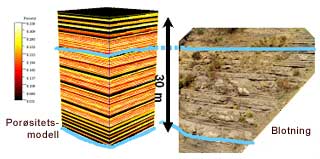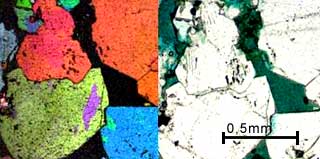Geology
Geology
Geological research at IGB has particular focus on understanding processes which lead to the formation and distribution of geological resources in the subsurface. The understanding of geological processes is important in the development of exploration models for both mineral and energy resources, both on the land and in the sea.
Advanced mineral characterization is an important part in several of the Institute’s research areas. In particular, the cooperation between electron microscope techniques and the development of up-to date methods in back-scatter diffraction (EBSD) should be mentioned, which has applications both in basic research in petrology, structural geology and studies of deformation mechanisms, and in applied research in process mineralogy and petroleum geology.
Mineral deposit geology/ore geology is an important part of the Institute’s research activity, and has emphasis on magmatic and hydrothermal mineral deposits. The study group compiles and uses knowledge in mineralogy, petrology and geophysics (magnetometry and gravimetry). The problem approaches in mineral deposit geology are closely linked to basic subjects such as magmatic petrology and geochemistry. An example of this is the cross-disciplinary PlatinumProbe project which studies deep mantle processes which have led to large magma provinces such as the Neoproterozoic magmatic province in Seiland, and the much younger classic Skjærgård intrusion on Greenland of Paleogene age. Late-magmatic and hydrothermal processes in granite systems are also important for the understanding of ore genesis, which is involved in research projects in both Cornwall and Norway. The research activity is particularly aimed at potential metal deposits, such as Cu, Ni, PGE, Sn and W, in addition to strategic industrial mineral resources, such as super-clean quartz and rare earth elements. Emphasis is put on understanding the underlying processes which control potential mineral deposits, and the effect these processes have on new and existing deposits.
Magnetometry and gravimetry are important geophysical methods in ore exploration and generally for the interpretation of dynamic processes in the Earth’s crust and mantle. Research on the magnetic properties of minerals is a relatively new activity at NTNU, and was established with the appointment of Prof. Suzanne McEnroe who has brought the institute high-level cutting-edge experience in this field. The research integrates mineral characterization from nano- to microscales and modelling of magnetic anomalies at large scales.
Arctic geology and petroleum geology are based on field expeditions to different parts of Svalbard and also includes research on geological materials from Svalbard and the continental shelf. The activities within Arctic geology have special focus on Mesozoic stratigraphy and sedimentology, and also include studies of sandstone provenance and diagenesis. An understanding of the geology of the shelf area has significance for the development of exploration models, predictions of reservoir properties, and for the storage of CO2. Research into organic sedimentation also includes quantitative calculations of parts of the carbon cycle for the interpretation of paleoclimates and sedimentation environments. Activities within reservoir geology combine mineralogy and petrography with sedimentology to interpret diagenesis and compaction processes in the sediment layers, in order to predict reservoir properties at depth.


